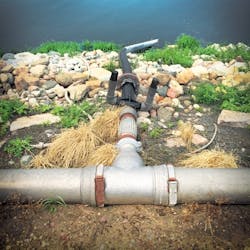Food & Beverage: Efficient Aeration
About the author: Jim Lauria is vice president, sales and marketing, for Mazzei. Lauria can be reached at [email protected].
One of the great challenges in the food and beverage industry—and great distractions, because it is about as far from the core business as it can possibly be—is wastewater treatment. Vegetable packing plants, wineries, breweries, dairy processing operations and other facilities are water-intensive from the start, and their wastewater can be high in biochemical and chemical oxygen demand (BOD and COD), organics and nutrients. The wastewater can also be loaded with fats, oils and grease (FOG), total suspended solids (TSS) and pathogens. And then there’s odor, the byproduct of chemically rich wastewater and the microbes that love it.
With all the attention paid to water quality and eutrophication in streams and lakes, as well as the public relations pressure to be a good neighbor, managing wastewater efficiently and effectively is vital to the food processing business.
It also is vital to the business resiliency of the operation. Good wastewater management can reduce expenses and also create an additional source of treated water for a wide range of plant functions. In areas where water is a limiting factor in business growth—due to scarcity or expense—tapping into wastewater as a resource makes great business sense.
A Challenging Task
Wastewater treatment in food processing facilities comes with special technical challenges. Volumes often are large. The quality—in pollutant load—can change from batch to batch, complicating chemical or activated sludge treatments.
For these reasons, proper aeration can be a highly effective tool for secondary wastewater management. But if aeration is not adequate or incomplete—failing to treat the entire depth of a pond—anaerobic bacteria can create odor compounds including hydrogen sulfide and methane.
A challenge in aeration circles is that many managers’ impression of aeration is a system of “eggbeaters”: a flotilla of rotating paddles, each with its own motor, churning furiously to incorporate air into the pond. However, even the most powerful surface aerators can only push oxygen 6 ft deep into the lagoon; after all, they are fighting the physics of bubbles that naturally float to the surface.
Air Injection
More efficient systems, utilizing Venturi injectors and mixing nozzles, make wastewater aeration more feasible for small and medium-sized food processing operations. In such systems, a fraction of wastewater from a pre-selected location in the pond is first pumped through Venturi injectors.
This aerated sidestream then is released and mixed with the bulk water in the lagoon via nozzle arrays at the bottom of the pond, optimally situated in order to facilitate complete mixing with minimal energy use. The geometry of the injectors results in a pressure differential, drawing air in through a suction port to mix with the fluid.
Such air injection systems require minimal energy and no chemicals. They work in tanks and ponds no matter how deep, enabling a reduced footprint. There is no splashing, minimizing worker or neighbor exposure to aerosols. Overall maintenance is minimal—the injectors and nozzles have no moving parts, and the onshore pump is the only mechanical element.
Processing plants that want to introduce an aeration step before wastewater is introduced to the pond—or want to introduce tertiary treatment with ozone or oxygen prior to wastewater discharge or reuse—can instead use the same principles of physics in a Pipeline Flash Reactor (PFR) system. As with the pond aeration system, gas is drawn into a sidestream flow through Venturi injectors and thoroughly aerated without the need for moving parts. Specially designed and optimally arrayed nozzles on each side of a length of pipeline inject the gas/liquid mixture into the bulk flow, using the physics of the pipeline and nozzles to maximize mixing and gas transfer.
CFD Modeling
Because they do not rely on pumps to overcome gas transfer challenges with horsepower, PFRs and pond injection systems must be carefully analyzed using computational fluid dynamics (CFD) to ensure optimum sizing and placement of each injector and nozzle.
Venturi injection nozzle energy needs are quite low, as long as careful pump specifications are encompassed. Pump horsepower, pipe diameters and oxygen transfer rates are set based on the volume and profile of the pond as well as the biochemical targets for the system. For instance, a facility eager to reduce BOD in its wastewater lagoon may utilize a larger pump and more nozzles to maximize gas transfer, while a plant just trying to eliminate odor complaints may be able to succeed with fewer injectors and less oxygen. Discharge standards, downstream treatment processes or reuse targets for treated wastewater also can guide aeration system specifications.
Download: Here
